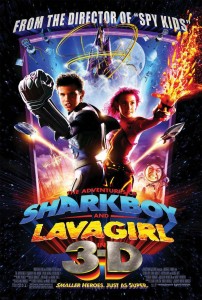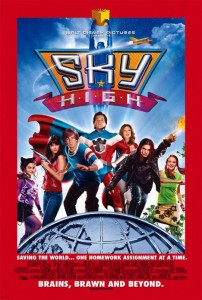In a multi-part series, Comic Book Film Editor William Gatevackes will be tracing the history of comic book movies from the earliest days of the film serials to today’s big blockbusters and beyond. Along with the history lesson, Bill will be covering some of the most prominent comic book films over the years and why they were so special. Today, we examine how superheroes are employed in kid-friendly fare, to good and bad effect.
Comic books, especially superhero comics, were at one time thought of as being exclusively entertainment for kids. Any adult who read comic books would be considered borderline illiterate and not someone you’d want to associate with. I’m fairly certain that there are many people out there that still hold that opinion.

But comics haven’t been exclusively for kids for almost three decades. While there are some comics that are aimed at the younger set, they are becoming rarer as the years pass. This is a shame not only because there is room in comics for both kids and adults, but also because the world of film has shown that superheroes can be quality entertainment for kids and adults at the same time.
A sterling example of this was 2004’s The Incredibles. This was the sixth film released by Pixar, who were well in the run of quality films by this point. The film was a pastiche on the Fantastic Four with that team’s surrogate family dynamic morphing into a biological family dynamic. Mr. Incredible was the Thing like strong guy, who was immodestly named like the FF’s Mr. Fantastic, whose power set was matched by Elastigirl. Violet had invisibility powers akin to the Invisible Girl and Dash had the youthful impetuousness of Human Torch and Jack-Jack seemed be able to turn into flame (amongst other powers as well).
While there was an antecedent for The Incredibles in the Fantastic Four, that doesn’t mean that it wasn’t original. It was, as most Pixar films are, a film that works for both adults and children, although The Incredibles gave the adults a little more to enjoy. The kids got the slapstick humor and flashy superpowers, while their parents got themes such as the Dad balancing family life with his “secret” identity. It was a film about the things you must give up in order to provide for the ones you love and the difficult pursuit of a satisfying balance between what you want to do and what you have to do.
The next film on our list is not quite as complex as The Incredibles, but is one of the few kid’s films to have a “Story by” credit given to an actual seven-year-old kid. That kid was Racer Max Rodriguez, whose father, Robert Rodriguez, decided to adapt the characters they both created around their house to the big screen in the form of The Adventures of Sharkboy and Lavagirl in 3-D.
 The film centers on a lonely outcast named Max who creates a world where young superheroes Sharkboy and Lavagirl live and have adventures. However, the line between fantasy and reality becomes blurred when the heroes ask Max to come with them to save their world.
The film centers on a lonely outcast named Max who creates a world where young superheroes Sharkboy and Lavagirl live and have adventures. However, the line between fantasy and reality becomes blurred when the heroes ask Max to come with them to save their world.
The film takes on a Wizard of Oz like dimension as many of the people Max knows appear in the dream world he created in different forms, yet tied to the way Max views them (for example, Max’s real life bully Linus becomes the villain Minus in Max’s fantasy world and his mean teacher Mr. Electridad becomes another villain named Mr. Electricity).
The film was a critical and box office disappointment, but is known for being one of the first films to usher in the 3-D resurgence and for being the first major film role of Taylor Lautner. All those Twimoms who get weak in the knees whenever he takes off his shirt in the Twilight films should take a look at that trailer up there. He’s practically a baby in this film. They should be overcome with shame.
If you are looking to create a superhero movie for kids, you could do worse for a plot than a superhero high school or a teenager dealing with famous superhero parents. Sky High combines both plot elements to good effect.
 The film had a lot going for it. It marked Kurt Russell’s return to Disney family fare (although now as the parent instead of the kid), featured geek culture icons Lynda Carter and Bruce Campbell, had a role for Broken Lizard’s Kevin Heffernan and reunited Kids in the Hall members Dave Foley and Kevin McDonald. It was like they were doing a movie with a collection of actors with large cult followings.
The film had a lot going for it. It marked Kurt Russell’s return to Disney family fare (although now as the parent instead of the kid), featured geek culture icons Lynda Carter and Bruce Campbell, had a role for Broken Lizard’s Kevin Heffernan and reunited Kids in the Hall members Dave Foley and Kevin McDonald. It was like they were doing a movie with a collection of actors with large cult followings.
The story was solid if conventional. The cast definitely made the most of the material and I really liked the end product. So much so, I am not ashamed to admit that I saw the film in a theater. However, it is with great shame that I admit that the very next year I saw a similarly themed film in the theaters, a film with a whopping 3% fresh rating on Rotten Tomatoes.
That’s not bad. For a long time, Zoom: Academy for Superheroes had a 0% fresh rating, meaning it received absolutely no positive reviews at all. I didn’t really consider the film to be that bad, I have definitely seen worse, but the film wasn’t very good either.
 If you were able to get past the fact that the federal government considers a six-year-old girl with super-strength to be a good line of defense against an incredibly powerful, homicidal super villain speeding his way towards Earth, you’d find other things about the film to make you wince. Like what, you may ask? Well, the reliance on gross-out gags for the sake of gross-out gags. There is an extended sequence where the four young trainees lock the more awkward scientist/trainer/mentor (played by a Chevy Chase who either just had bad plastic surgery done or is coming off a bad allergic reaction to a bee sting) in a room used to train the potential heroes how to react to adverse weather conditions. After Chase’s character is pelted by rain, sleet, snow and struck by lightning, a robotic skunk (yes, a robotic skunk) comes out and sprays (yes, the robot skunk has functioning anal scent glands) him in the face. It’s a pretty good spraying. If I recall correctly, Chase allows some of the spray to go into his mouth, which, you know, is one way to make it funnier. Well, if the scene was funny to begin with, maybe.
If you were able to get past the fact that the federal government considers a six-year-old girl with super-strength to be a good line of defense against an incredibly powerful, homicidal super villain speeding his way towards Earth, you’d find other things about the film to make you wince. Like what, you may ask? Well, the reliance on gross-out gags for the sake of gross-out gags. There is an extended sequence where the four young trainees lock the more awkward scientist/trainer/mentor (played by a Chevy Chase who either just had bad plastic surgery done or is coming off a bad allergic reaction to a bee sting) in a room used to train the potential heroes how to react to adverse weather conditions. After Chase’s character is pelted by rain, sleet, snow and struck by lightning, a robotic skunk (yes, a robotic skunk) comes out and sprays (yes, the robot skunk has functioning anal scent glands) him in the face. It’s a pretty good spraying. If I recall correctly, Chase allows some of the spray to go into his mouth, which, you know, is one way to make it funnier. Well, if the scene was funny to begin with, maybe.
On top of that, we get a Smash Mouth-heavy soundtrack, an extended Wendy’s commercial in the middle of the film, a countdown to disaster that doesn’t countdown in linear fashion (it goes from one day to two days then one day again), and Courtney Cox trying to act nerdy and clumsy. If you take away all of that, you have a relatively harmless kids flick. But the problem is, you can’t take all that away.
 It’s only fitting to end this installment with Megamind after starting it with The Incredibles, because the two films have a number of similarities beyond both being CGI animated superhero kid flicks. Both films opened on the same day (November 5th), albeit six years apart. One is done by Pixar, the other by Pixar’s main competition in quality and profitability, Dreamworks. Both draw their inspiration from comic book mythos’ (the Fantastic Four mythos is to The Incredibles as the Superman mythos is to Megamind). Both appeal to adults as well as kids. And both are humorous examinations on superhero tropes.
It’s only fitting to end this installment with Megamind after starting it with The Incredibles, because the two films have a number of similarities beyond both being CGI animated superhero kid flicks. Both films opened on the same day (November 5th), albeit six years apart. One is done by Pixar, the other by Pixar’s main competition in quality and profitability, Dreamworks. Both draw their inspiration from comic book mythos’ (the Fantastic Four mythos is to The Incredibles as the Superman mythos is to Megamind). Both appeal to adults as well as kids. And both are humorous examinations on superhero tropes.
This film takes a look at the stereotypical super villain who wants nothing more than destroy the superhero of the city he lives in. What happens when he gets what he wishes for? Well, create a new enemy to destroy, become a hero himself, and/or both.
The film had a great cast that would have been perfect even if the film was live-action. I mean, wouldn’t you want to see Brad Pitt, Tina Fey, Jonah Hill and Will Ferrell together in just about anything? While it wasn’t quite as good as The Incredibles, it was good in its own right.
Next time, we discuss why it is best to use original superheroes if you want to make a superhero comedy.




